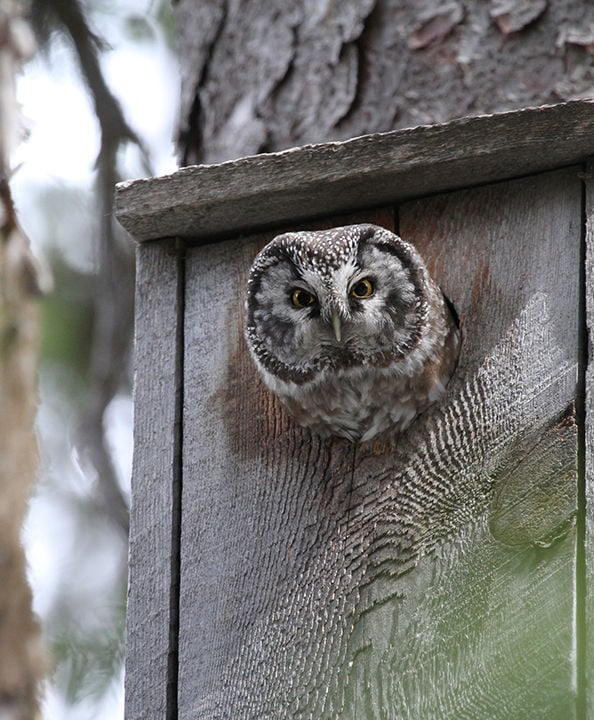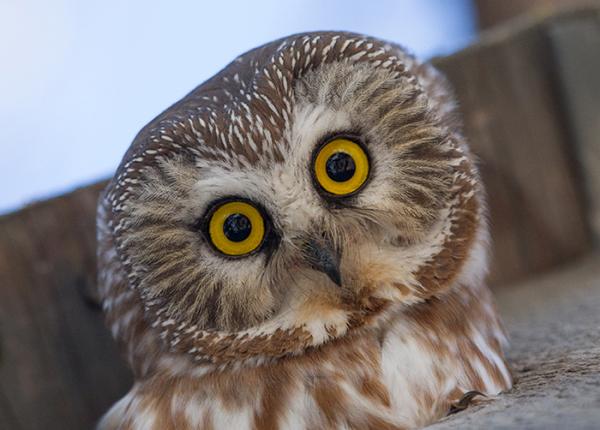I just came upon this great article and wanted to share it with you all to highlight an issue we probably don’t spend much time thinking about.
Two years ago, I had a pair of Carolina Wrens try to build a nest in my favorite hanging plant outside, so I wanted to build them a nesting box to encourage them to not live in my expensive plant. (They ended up not nesting there, but I accidentally killed the plant anyway…) In looking up designs, I became aware that there was not one basic birdhouse that worked for whatever bird felt like using it. There were a lot of requirements to have a safe nest box that I had never considered.
Different birds need different sized holes. They of course need a hole big enough to get in, but also small enough to keep out larger, more aggressive birds and other predators. Some birds need a little landing post to land on before going in the hole, while for others, that landing post can be a liability, again allowing predators to access the nest. It needed and internal volume large enough for a nest, but not too large. It needed drainage to avoid standing water and mold.
One final consideration that also makes sense now, is heating and cooling. Besides having ventilation to keep clean air inside, the material the nest box is made of is very important. You don’t want to trap excessive heat, and you don’t want something that will remove too much heat also. Much like our own homes, a safe climate is required for the birds’ shelter and overall health.
Nesting box plans have been provided by many animal groups for decades, but it appears what has worked to great benefit in the past may now be doing more harm than good. With increasing global temperatures, many house designs are now too hot to safely raise young birds, forcing them outside to early, or being fatal to the growing birds that can’t try to escape the heat. Location of the box is also becoming more critical, making a source of water nearby even more essential than before.
This article discusses the problems people are noticing with current nest box practices, and some ideas to work toward correcting them.
I know there are a bunch of climate and conservation communities on Lemmy, so if you feel like cross-posting, feel free, or if you would like me to do it, let me know. I spend most of my time here preparing posts and not exploring as much as I used to, so I’m behind on what all the rest of you have going on here a lot of times. Even if there are some sad things in this article, I hope you enjoy the information it provides.
From Hakai Magazine:
After scores of barn owls died in overheated nest boxes, conservationists set out to give the birds less heat-prone homes. by Larry Pynn May 15, 2024
For several scorching days in June 2021, an oppressive heat dome sat over western North America. In the Fraser Valley, inland from Vancouver, British Columbia, the temperature soared to 42.9 °C. The previous June high for the area—set in 1982—was 34.7 °C. Unable to escape the extraordinary heat, billions of marine creatures died—most noticeably barnacles, mussels, oysters, and clams.
On land, Sofi Hindmarch, a wildlife biologist with the Fraser Valley Conservancy, tallied the heat dome’s horrifying impact on young owls.
At nine locations across the Fraser Valley, Hindmarch, biologist Dick Clegg, and farmers documented juvenile barn owls that had fled their nest boxes. Like people bolting from an apartment fire, the owlets jumped to escape the overwhelming heat. At seven of those sites, the researchers found corpses strewn on the ground below the nest boxes. These owlets were too young to fly, and their parents did not feed them on the ground. From the eighth location, Hindmarch collected three fallen but uninjured young owls and took them to a rehabilitation facility; they survived and were eventually released. In the ninth case, two young owls that fell from a nest box in a barn managed to land in hay, where their parents continued to feed them until they were old enough to fledge—typically around 60 to 70 days old.
Along with these grisly findings, the study authors documented 28 dead barn owl babies, aged 20 to 45 days, inside their nest boxes. “For me, it’s extremely rare to find a batch that is almost ready to fledge all dead,” Hindmarch says.
When she began studying the region’s barn owls more than two decades ago, extreme heat was the last thing on her mind. Barn owls originated in the tropics, and the Fraser Valley sits within the species’ uppermost limit in North America, Hindmarch says. “I honestly never envisioned that overheating would be an issue for them,” she says. “It came as a bit of a surprise. We never used to get temperatures like we do now.”
While the changing climate and soaring heat are at the heart of this tragedy, part of the problem stems from the very nest boxes the owlets were abandoning.
Built out of plywood and erected on freestanding poles or affixed to the sides of barns, many nest boxes were exposed to direct sunlight, exacerbating the skyrocketing temperature outside. Hindmarch and her colleague later found that owlets living in pole boxes within 350 meters of the coast, however, survived. At the outlet of the Fraser River, where it dumps into the cooler Strait of Georgia, the 2021 heat dome temperature peaked at 32.4 °C—more than 10 °C cooler than at sites farther inland.
Nest boxes have long been used to give birds a helping hand, but for Hindmarch, the disaster showed it was time to reconsider their design and placement.
To that end, Hindmarch and volunteers with the Cascade Bird Box Team have retrofitted about 30 nest boxes in the Fraser Valley study area since the heat dome. They made some of the boxes larger and added ventilation holes. They repositioned other boxes so they’re out of direct afternoon and evening sun. And for the boxes most exposed to sunlight, volunteers covered the old roofs with white sheet metal to reflect the heat, leaving a gap between the two surfaces to improve air circulation. Together, these modifications have lowered the peak daytime summer temperatures inside the boxes by about 5 °C.
But improving nest-box design is only part of the solution, says Katherine Lauck, a graduate student in ecology at the University of California, Davis, who was not involved in the barn owl work. Lauck recently coauthored a study showing how birds—much like people seeking the coolness of forests on a hot day—need natural spaces to cope with climate change–induced heatwaves.
Species such as western bluebirds and tree swallows, Lauck found, fare better when nesting in boxes near shady forests, which act as a buffer from heatwaves. Boxes on open farmland are more susceptible to extreme swings in temperature.
Human-dominated landscapes, such as farms, says Lauck, also restrict the birds’ access to water and food, making them even more sensitive to temperature extremes. One way to improve birds’ odds of success in a warming world, Lauck says, is to add shade to agricultural land. “Patches of natural vegetation interspersed with crops are going to be really important to allow birds to cope,” Lauck says.
Hindmarch agrees that updating nest boxes is just one step toward solving this complex problem. Barn owls are adaptable creatures that live on all the world’s continents except Antarctica. Protecting mature trees and dead snags—which offer nesting cavities for barn owls—as well as areas such as wetlands and natural grasslands will go a long way to improving the species’ chances of enduring the juggernaut that is climate change.


I love this shot. ❤️
I keep forgetting to post the article about staged “nature” shots from “back in the day.” It has a great part about how they got to take pictures inside a Flammy’s nest! 😨






This was an interesting read. I never really thought about all the considerations that go into building a nest box. How sad that things meant to help owls are basically turning into ovens and killing them. Hopefully the alterations will help.
I know! I’m guilty of having previously lumped most birds together in one category, but as I’ve learned more about them, I’ve really come to appreciate how different not only different species can be, but also individual birds. They seem to have as much distinct personalities as anyone’s dog or cat, with their own particular likes and dislikes.
It’s good they are making these observations so they can figure out what is going to work better in the near future. I know it would break my heart if I put something out for the animals and it ended up hurting them. I liked how the article talked about how we made assumptions about their heat tolerance because some of the same looking owls live in hotter places year-round, but just as some people live in the Amazon or Himalayas, most of us probably wouldn’t do well if we suddenly ended up there without time to acclimate to it gradually.
Makes me wonder if that paper I got about how to make a screech owl nest is still accurate…
Not sure when this was last updated, but here is a link to the Audubon Screech Owl nest box plans.
Thanks! I’ll take a look and compare the two.
Something a little off topic (and I guess a lot of people know this already) - during the summer we are putting out dishes with water. Either they are shallow enough that birds and other animals don’t accidentally drown or with deeper pots we put in stones in the middle that will stay above the water line. And for insects (that also need water) we offer a flat wood which helps them to climb out. Survival or potential snack for animals.




